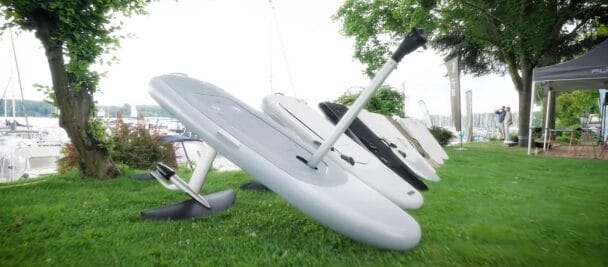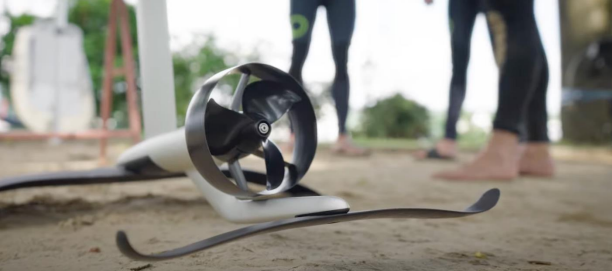

Is Flite Jet The Future of eFoil Propulsion Systems?

When it comes to choosing the right propulsion system for your eFoil, both the Flite Jet
and Flite Propeller have their strengths, but it’s important to consider where the future
of this technology is heading. With Flite rapidly innovating, it seems clear that conical
wings and jet propulsion will be integral to future developments. Here’s a breakdown
of what each system offers and why it might be worth thinking ahead when investing in
your setup. To see how propulsion systems pair with each model, explore our fliteboard collection.
The Shift Toward Jet Propulsion & Conical Wings: Why It Matters
As eFoiling becomes more sophisticated, Flite is evolving toward more integrated,
streamlined systems. The Flite Jet propulsion system and conical wings are prime
examples of this shift.
Hydrodynamic Performance & Efficiency
Conical wings offer a more hydrodynamic shape, reducing drag. Traditional wings
(commonly referred to as slab or surface mount wings) often come with screws or other
components that, while necessary for assembly, add minor points of energy loss and
drag in the water. Over time, these little inefficiencies can make a noticeable difference
in how smoothly and responsively your eFoil handles.
With conical wings, the design is sleeker and more integrated, with fewer parts that
can cause drag. This means you’ll feel more connected to the board and experience
better energy transfer as there are fewer areas where rigidity or performance could be
compromised. The best tolerance is a solid unit, so breaking away from screws is the
apex of the design
Tolerances & Response: Conical wings also have tighter tolerances, translating to a
more precise response from the rider’s input. When you shift your weight or make
adjustments on the water, the wing reacts faster, making your ride feel more responsive
and intuitive. There’s less lag between your movement and the board’s reaction, leading
to a smoother and more controlled experience. Moving towards a propulsion system like
the Flite Jet, designed with these advancements in mind, ensures your system remains
future-proof as more refined designs become the industry standard.

Why Invest in the Flite Jet?
While the Flite Propeller is still a top-tier option, it’s essential to keep an eye on the
future. The Flite Jet offers several key advantages that appeal to riders looking for
safety, smoothness, and the latest technology.
Safety First: The Flite Jet’s biggest standout feature is safety. Without an external
propeller, there’s zero chance of injury from contact with blades. This makes it a go-to
option for families, beginners, and anyone concerned about minimizing risks on the
water.
Smoother Ride: One of the Flite Jet’s most notable benefits is its smooth ride. With
minimal drag and a compact design, you’ll notice a difference in how the board feels
beneath you, especially when cruising at slower speeds or making gentle turns. The
reduced vibration and noise add to a more peaceful, enjoyable experience.
Forward-Looking Investment: Choosing the Flite Jet today is a strategic decision. As
more eFoil systems shift towards jet propulsion and integrated wings, investing in
this system now means you’ll have future-proof equipment that aligns with where the
industry is heading. The reduced drag and tighter design tolerances of conical wings
further enhance the advantages of the jet system, ensuring you’re getting a
performance-driven product.

Where the Flite Propeller Still Shines
It’s important to recognize that the Flite Propeller is still one of the best propulsion
systems in the eFoil industry.
Efficiency & Speed: The Flite Propeller is incredibly efficient. It provides greater
thrust and higher top speeds than the Flite Jet, making it an excellent option for those
who want maximum performance on the water. Whether you’re aiming for long rides
with the Flitecell Nano battery or pushing for top speeds, the Flite Propeller delivers
unmatched efficiency and power, giving riders plenty of room for high-speed
adventures.
Versatility: The propeller system is incredibly versatile, working seamlessly with all
Fliteboard models. It’s designed to suit a wide range of riding styles, from high-speed
cruising to advanced tricks and maneuvers. If you’re not prioritizing the safety features
of the Flite Jet, and your primary concern is performance and efficiency, the Flite
Propeller is the better option in terms of speed, range, and cost-effectiveness.

Pros & Cons Comparison: Flite Jet vs. Propeller
The Flite Jet and Flite Propeller are incredible propulsion systems, each offering
unique advantages. The Flite Propeller stands out for its efficiency, speed, and
versatility, making it a great all-around choice for those looking for the best value and
immediate performance.
However, the Flite Jet is the clear winner if you’re focused on safety and smoothness
and want to invest in a future-proof system. As Flite continues to innovate, the trend
toward jet propulsion and conical wings shows where the future of eFoiling is
headed. Choosing the Flite Jet is not just about enjoying superior safety and ride
quality—it’s about ensuring your eFoil stays at the forefront of tomorrow’s performance
standards.
No matter which you choose, you’ll be riding with some of the best technology in the
eFoil world.
Hydrodynamics 101: Why It Matters in eFoiling

Hydrodynamics is the study of how objects move through water, and it plays a massive
role in eFoiling, especially as the technology gets closer to the feel and performance of
unpowered hydrofoils. The smoother and more efficient your hydrofoil wing design is,
the less drag you experience—and that directly translates to a faster, smoother, and
more responsive ride. But what does all of this mean?
Let’s use the analogy of Riding a Bike.
Imagine riding a bike with a flat tire—that’s a lot of resistance, right? Now picture the tire
fully inflated—it’s easier, faster, and requires less effort. This is a simple way to
understand hydrodynamics. On an eFoil, the less water your board has to “push”
aside (like the air resistance on an airplane wing), the easier and faster it will glide
through the water.
When an eFoil is designed with hydrodynamics in mind, like the Flite Jet and conical
wings, it means less drag, more speed, and less energy wasted. Instead of battling the
water, you’re moving smoothly and efficiently.
Why Is Less Drag Important for eFoils?
Less drag means:
More speed: You don’t need as much power to reach the same speeds, which means
longer rides on the same battery and less taxing on the system as a whole.
Better control: With less water resisting your movements, your eFoil responds more
quickly to every shift in your weight. This allows for more maneuverability—so you can
carve smoother turns and even perform tricks more easily. If you’re an eFoil surfer, this
is really important.
Closer to Unpowered Foiling: As eFoil designs improve, they start to feel more like
unpowered hydrofoils (which rely on just the rider’s movement to stay on foil). This is
exciting because the closer eFoils get to that experience, the more fun you can have on
the water—without relying as much on the motor to keep you going. You’re getting
closer to flying over water!
It’s an exciting time to be part of the eFoil community. As hydrodynamic designs
improve, the lines between powered and unpowered foiling are starting to blur. Riders
are gaining more control, more play with their foils, and a more natural connection with
the water.
If you have any questions about eFoil propulsion systems, wings, or anything else eFoilrelated, call (850) 400-8500 or email us at [email protected] for a custom recommendation. Or book a hands-on experience with our Inlet Beach eFoil lessons to try both systems in real conditions.
Please fill out this form and someone from our team will contact you as soon as possible. You can also reach us by email at [email protected]